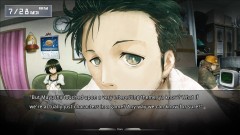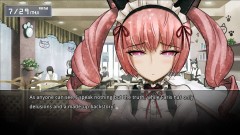Special note: Due to the story-heavy nature of Steins;Gate, there are a lot of spoilers, both major and minor, contained within this review. Since conspiracies are an important theme in this game, I’ve “redacted” said spoilers. To see this text, hover your mouse cursor over the black bars.
Usually, when I preorder a game, it’s for one of two reasons: I want to play it right away (the StarCraft IIs of the world) or I don’t necessarily want to play it right away, but still want to support it (the Bravely Defaults of the world). Rarely have I preordered a single game to support an entire genre, but that was what I did when it came to JAST USA’s localization of the Windows port of Steins;Gate (it was originally an Xbox 360 exclusive in Japan): I did it in the hope that we might see more English-translated, non-hentai PC visual novels in the future. Steins;Gate is hardly the first such product, but it’s one of the most important ones we’ve seen in some time, or at least since Ever17 and/or Higurashi: When They Cry. It’s also the second and most successful of Nitroplus and 5pb.’s “Science Adventure” standalone VNs (released after Chaos;Head and before Robotics;Notes), and the first to be officially localized in English. So, in the end, does Steins;Gate live up to the hype?

This visual novel takes place in modern-day Akihabara, the Tokyo neighborhood famous for its electronics and anime/game otaku stores. The narrator and POV character is one Rintaro Okabe, a college student who spends a good deal of time as his alter ego, Hououin Kyoma, a self-described mad scientist on the run from “the Organization”. This is all in his head, of course. Along with his classmate Itaru, aka Daru, and childhood friend Mayuri, aka Mayushii, he spends his summer vacation running the Future Gadget Laboratory, basically an apartment hangout above the Braun Tube Workshop, a store specializing in old CRT television sets. The “gadgets” they make in the “lab” are, for the most part, laughable failures, but then something bizarre happens one afternoon. This mysterious event leads to the lab’s fourth member, a prodigy and real scientist named Kurisu, joining the team, as well as further investigation into the latest gadget, the PhoneWave (name subject to change), which was originally intended as a remotely controlled microwave but may in fact be some sort of time machine.
As this is a traditional VN, there is very little interactivity. Apart from the True End, the routes to the endings are fairly straightforward, and other, smaller, in-game decisions lead to extras and achievements. All of the player’s actions are not carried out through the expected dialogue trees, but are determined by what is done with Okabe’s cell phone, which can be whipped out at almost any time and interacted with. Aside from replying to emails and (sometimes, rarely) talking on the phone, the player can change the wallpaper and ringtones, and, amusingly, access the Future Gadget Lab’s website, which opens in your computer’s default browser. Of all of the phone’s functions, emailing is the most cumbersome. You can answer emails by clicking on select phrases within them, but you’re locked into your choice and can’t go back to see how Okabe would reply to the others; in addition, these replying options seem to disappear after a set amount of time has passed.
What’s more irritating about the phone menu is that I discovered it purely by accident. The phone menu opens when moving your mouse cursor all the way to the right, or by pressing the “P” key. Neither of these moves is mentioned in the pause menu, which I also just happened upon and contains information on what all the other controls are. Note that at the time, I was playing the download version of the game, which does not come with a manual or even a readme file (the Limited Edition comes with a printed manual; not sure about the standard physical version, which hasn’t come out yet). As the phone menu is the main gameplay mechanic, this is a major oversight; a rudimentary control/hotkey guide accessible through the game’s start screen, or even just as a separate text file, would’ve greatly improved my initial experience. ETA (05/06): I’ve since noticed that that there is a PDF manual for the download version, though it has to be downloaded separately from the rest of the game’s files.

The character graphics are designed by huke, the popular illustrator who created Black Rock ★ Shooter, and are unmistakably his creations: white circles in the irises, sharp chins, tiny mouths, and lots of dappled texture patterns. This art isn’t perfect; sometimes, the anatomy looks a little wonky, especially in a few scenes featuring Tennouji, aka Mister Braun, the muscular manager of the CRT shop. There is also a technical glitch in at least one spot when a character is zoomed in on, where the mouth animations don’t quite line up with the still face. The backgrounds fare better, capturing both the real-life and imaginary settings quite well, and include a few arresting and memorable images. The localized text is well-written—respectful of its source while being accessible to English speakers—and contains only a handful of grammatical errors. It’s worth noting that this localization uses a mix of real names (for example, the otaku stores Animate, Toranoana, and Mandarake) and fictionalized ones (Starbecks, Dr. P, etc.). I’m not sure if this is equally true for the Japanese original, but it wouldn’t be surprising if it is. As for the music, it’s the type of bordering-on-generic stuff typical of an above-average anime; appropriate but not particularly distinctive, in other words.

And speaking of which, both the story and the characters are anime as hell. Okabe starts off as the most unusual character in the ensemble, but later follows a path of personal growth, much like heroes in other Japanese media. Mayuri is a childlike airhead and cosplay seamstress who is mostly endearing, occasionally irritating, and sometimes shrewdly observant. “Super Hacka” Daru accurately describes himself as a “gentleman pervert”—he gets along respectfully with “3D girls”, but loves the 2D ones in eroge and can find moe in anything, including the Large Hadron Collider. Kurisu is level-headed most of the time, logical almost to a fault, and a closet Internet Person. Then there’s male shrine maiden Luka, catgirl waitress Faris, cell phone addict Moeka, and Braun Tube Workshop part-timer Suzuha, rounding out what would be a harem in nearly any other game. The harem/dating sim elements are made much more obvious in the second half of the game, where large chunks of backstory about most of the female characters is revealed, and deciding what “route” to take to what ending essentially boils down to what girl to choose. There are some other characters, but aside from the ones named above and the previously mentioned Mister Braun, they play only minor roles.
All of these characters are key participants in a conspiracy-heavy story inspired by the real-life tale of John Titor, an alleged time traveler from 2036 who appeared on an internet messageboard back in 2000. The main villain is SERN, a fictionalized version of CERN, the famed nuclear research organization. In Steins;Gate, it turns out that SERN has been researching time travel, and it’s this research which leads them to take over the world in 2034. Still, despite his anxieties over SERN’s methods and secrecy, not to mention his own worries about affecting the past, Okabe cavalierly encourages his friends to fulfill their personal wishes using the PhoneWave (name subject to change) after his first successful controlled experiment, which involved winning lottery numbers and was one in which he seemingly becomes the only person to have remembered what the world was like before the past was altered. This carefree approach to the Lab’s time travel experiments, in which brief emails, called “D-Mails”, are sent to the past, contrasted sharply with the scenes that had come before, and seemed to me to be somewhat out of character for Okabe.
After all is said and done, it’s revealed that Moeka is an agent of SERN’s who, during a raid of the lab, kills Mayuri. Conveniently enough, this happens shortly after the completion of the PhoneWave (name subject to change)’s successor, the Time Leap Machine, which can send a person’s memories (and, as it quickly becomes obvious, their consciousness) up to two days into the past. Okabe uses the Time Leap Machine to try and prevent Mayuri’s death, only to find himself failing every single time. Eventually, he learns that in order to escape the “worldline” on which Mayuri dies, he must re-obtain the IBN 5100 computer that he had borrowed several days ago—which had disappeared from the lab during the fulfillment of one of his friends’ wishes—and use it to hack into SERN and delete the first D-Mail from an encrypted database. Naturally, this means undoing all of the effects of the successful D-Mails that his friends had sent.

There are some small inconsistencies here and there, but, unfortunately, the culmination of the story contains the most gigantic plot hole in the entire game. It turns out that, for some weird reason, deleting that initial D-Mail from SERN’s database would return the world to the past in the Prologue, in which Kurisu died. From a practical standpoint, this makes no sense whatsoever, not least of which because SERN’s D-Mail is a copy of the original sent from Okabe to Daru, and, more importantly, in order to delete it, no time travel is involved. On the date on which Okabe has to decide whether or not to delete the D-Mail, it has existed on that database for about two weeks; it seems like the idea that deleting it would mean that “it never existed” is being taken far too literally here. That said, in a way, it’s rather cheap and dishearteningly silly to have to decide between the very lives of either Mayuri or Kurisu (and having the future be either a nuclear wasteland or a SERN-ruled dystopia, respectively, though these concerns aren’t nearly as important to Okabe) when the mechanism for doing so makes no logical sense whatsoever. For the record, when it came to this point, I chose to save Mayuri and kill Kurisu… and yes, according to the game, the past was changed and Kurisu went back to being dead. There’s also the matter of the second successful D-Mail, the lottery one, which wasn’t only not cancelled, but was largely forgotten about altogether.
These end-game events led me back to a thought I had during the prologue: is Rintaro Okabe a reliable narrator? Sure, the Hououin Kyoma alter-ego is pretty much dead by this point, but after embarking on the Mayuri route, and not long before the SERN database deletion was carried out, Kurisu left Akihabara to fly back to the United States. That said, it lessens the impact of her dying, or “dying”: either way, Okabe’s memories would be pretty much all he had left of her.
As of this writing, I’ve only seen Mayuri’s ending and not any of the others, though I might go back and at least check out Suzuha’s, since she ended up being my favorite character. The fan book which came with the Limited Edition contains, among other things, plenty of spoilers for all of the endings, including hints for actions that need to be taken to reach them. It makes for interesting reading if you, like me, have played all the way through and have reached one ending, but don’t have a terribly strong need to see any of the others. However, if you have the LE and don’t want anything spoiled, don’t so much as flip through it until you’ve seen all the content you want to see.
Steins;Gate is flawed, and I’m still not completely sure if its high points make up for the troublesome final act, but thanks to its endearing characters, solid production values, and the occasional surprise (which was always welcome, since thanks to some heavy-handed foreshadowing, some major revelations were ones I had correctly guessed about well ahead of time), most of my experience was good. It’s not about to usurp Last Window or the second Ace Attorney from the lofty positions they hold in my own personal visual novel rankings, and it is nowhere near as good as Ghost Trick, my favorite adventure game of any kind, but Steins;Gate has its merits. In the end, my main hope for this game hasn’t changed: that as a high-profile ambassador for PC visual novels in English, it does well enough to ensure more and better such titles to be localized in the future.